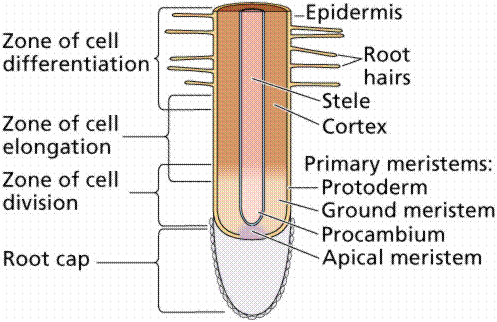How Plants Absorb Nutrients: The Apoplastic and Symplastic Pathways In Detail
Idea inspo @ViralAntIsCool (you probably forgot you asked me to write about this but you did lol)
Fun fact: the word "apoplast" was coined by a dude named Münch. 🧊🌶️
Plants absorb nutrients from the soil through root hairs, which serve to increase the absorptive surface area of roots. Here’s what roots look like:
From the transverse section diagram (the one that looks like a circle and thus is cut transverse to the longitudinal plane), try to deduce the pathway by which materials move from the soil into the roots. Let’s look at two pathways used to absorb materials from the soil: the apoplastic and symplastic pathways. Both are diagrammed below:
In the apoplastic pathway, materials move between cells, but they do not enter cells until they reach the Casparian strip, when they enter endodermal cells. If they don’t enter endodermal cells, materials remain outside the vasculature and are thus not absorbed by the plant. The apoplast has many cool functions that you've probably heard of. The apoplast hosts endophytes (mutualistic bacteria, such as those that fix nitrogen for the plant - e.g. Rhizobium). The apoplast initiates and spreads systemic acquired resistance (full-body plant immune response against pathogens) via salicylic acid signal propagation.
In the symplastic pathway, materials move from cell to cell via plasmodesmata, and only enter apoplastic (extracellular) territory once they reach the vessels (xylem and phloem are considered apoplastic as the fluid-conducting portions are extracellular).
Materials that pass through the symplastic pathway have already been filtered in their initial entry through the cell wall. They can easily enter the vascular cylinder via the endodermal cell layer. For the apoplastic materials to enter endodermal cells, they must pass through passage cells, which are openings in endodermal cells.
Passage cells are special because they don't have suberin. The rest of the endodermis is coated with suberin, an aromatic and aliphatic (hydrophobic/lipophilic) protective substance that repels water and prevents entry of solutes. Because passage cells don't have suberin, they allow previously-apoplastic materials to enter the symplastic pathway to help them continue their journey towards the vascular cylinder. If there is something like a toxin that the plant doesn't want to enter the endodermal cells, induced suberization occurs; in the places where the toxins are trying to enter, a suberin layer forms, preventing passage through to the vasculature; the passage cells are blocked by a barrier. But as long as the endodermal cell is alive, the plasmodesmata inside and between still work to transport things; suberin is just a barrier that doesn’t let stuff into this network.
To be clear, both the symplastic and apoplastic pathways require entry into the endodermis to reach the vascular cylinder, and the method by which they can enter the endodermis is via passage cells. The unique thing about apoplastic materials is that their first entry into intracellular transport pathways is via the passage cells, whereas for symplastic transport, the passage cells don't serve a particularly interesting role; they're just another hole for the symplastic materials to go through.
Yeah. Here are some resources to learn more about this topic:
Review about endodermis that explains its function well: https://pubmed.ncbi.nlm.nih.gov/28750257/.
Review about passage cells specifically, and suberin stuff: https://nph.onlinelibrary.wiley.com/doi/10.1111/nph.17182.
https://en.wikipedia.org/wiki/Apoplast#Apoplastic_transport - Wikipedia about apoplast. This article is kinda scuffed but it's a good place to find cool topics to explore further.









